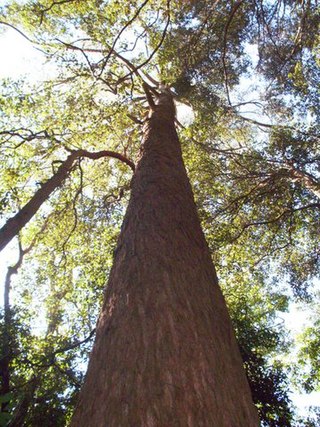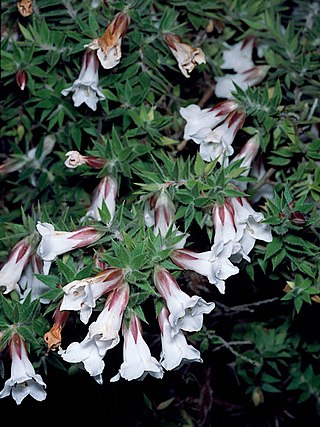
Phebalium nottii, commonly known as pink phebalium, is a species of shrub that is endemic to eastern Australia. It has branchlets with silvery scales, oblong to elliptical leaves, deep pink to mauve flowers arranged in umbels of up to six, with the stamens distinctively offset to one side of the flower.

Eucalyptus fastigata, commonly known as brown barrel or cut-tail, is a species of medium-sized to tall tree that is endemic to southeastern Australia. It has fibrous or stringy bark on the trunk and larger branches, smooth bark above, lance-shaped to curved adult leaves, flower buds in groups of eleven or more, white flowers and conical or pair-shaped fruit.

Leucopogon fletcheri is a species of flowering plant in the heath family Ericaceae and is endemic to south-eastern continental Australia. It is a densely-branched shrub with sharply-pointed oblong leaves, and pendent, tube-shaped white flowers in pairs in upper leaf axils.

Boronia deanei, commonly known as Deane's boronia, is a plant in the citrus family Rutaceae and is endemic to the central and southern highlands of New South Wales. It is an erect shrub with crowded, strongly aromatic leaves and white to bright pink flowers in late winter and spring.

Leptospermum rotundifolium, commonly known as round-leaved tea tree, is a species of flowering plants in the family Myrtaceae and is endemic to New South Wales, naturalised in Victoria and Western Australia. It is an erect shrub with more or less circular leaves but with a small point on the tip, and relatively large pink or white flowers.

Boronia granitica, commonly known as granite boronia, is a plant in the citrus family, Rutaceae and is endemic to a small area of eastern Australia. It is an erect shrub with many branches, compound leaves and pink, four-petalled flowers.

Boronia repanda, commonly known as the granite rose, repand boronia or border boronia, is a plant in the citrus family Rutaceae and is endemic to an area near the eastern border between New South Wales and Queensland in Australia. It is a small erect, woody shrub with many branches, thick warty, oblong leaves and pink, rarely white flowers arranged singly in leaf axils.

Leptospermum macrocarpum is a species of shrub that is endemic to the Blue Mountains in New South Wales. It has thin, hard, sometimes gnarled bark on the older stems, broadly elliptical leaves, relatively large white, pink or dark red flowers and large fruit.

Goodenia dimorpha is a species of flowering plant in the family Goodeniaceae and is endemic to the Sydney region. It is an erect herb with adventitious roots, linear to egg-shaped leaves, mostly at the base of the plant, and panicles of yellow flowers.

Epacris sprengelioides is a species of flowering plant in the family Ericaceae and is endemic to a small area in the Blue Mountains in New South Wales. It is an erect shrub with shaggy-hairy branchlets, more or less erect, narrowly elliptic leaves, and white or cream-coloured, tube-shaped flowers.

Prostanthera granitica, commonly known as the granite mintbush, is a species of flowering plant in the family Lamiaceae and is endemic to eastern Australia. It is a spreading shrub with egg-shaped leaves with the edges rolled under, and purple to violet flowers.

Prostanthera teretifolia, commonly known as turpentine bush, is a species of flowering plant in the family Lamiaceae and is endemic to a restricted area of New South Wales. It is an erect to spreading, aromatic shrub with more or less cylindrical leaves and bluish-purple flowers.

Goodenia glomerata is a species of flowering plant in the family Goodeniaceae and is endemic to the south coast of New South Wales. It is an erect, hairy herb with elliptic to lance-shaped leaves, mostly at the base of the plant, and compact spikes of hairy yellow flowers.

Hibbertia elata is a species of flowering plant in the family Dilleniaceae and is endemic to a eastern Australia. It is an open shrub with hairy stems, clustered, narrow linear to narrow lance-shaped leaves with the narrower end towards the base, and yellow flowers usually with fifteen to twenty-five stamens arranged around the three carpels.

Pultenaea cinerascens is a species of flowering plant in the family Fabaceae and is endemic to central New South Wales. It is an erect to spreading shrub with narrow oblong to wedge-shaped leaves, and groups of yellow and red flowers.

Bossiaea concolor is a species of flowering plant in the family Fabaceae and is endemic to eastern Australia. It is an erect shrub with elliptic to oblong or egg-shaped leaves with the lower end towards the base, and yellow and red flowers.

Epacris hamiltonii is a species of flowering plant in the family Ericaceae and is endemic to the Blue Mountains in New South Wales. It is a slender, low-lying to ascending shrub with hairy branchlets, thin, flat, hairy egg-shaped leaves, and white, tube-shaped flowers arranged in small groups at the end of branches.

Pimelea bracteata, is a species of flowering plant in the family Thymelaeaceae and is endemic to the south-west of New South Wales. It is a shrub with narrowly egg-shaped to elliptic leaves and pendulous, pale green heads of pale yellow flowers.

Vittadinia muelleri, commonly known as narrow-leaf New Holland daisy, is a flowering plant in the family Asteraceae. It is a small perennial forb with bright green leaves and purple daisy-like flowers. It grows in New South Wales, Victoria, Tasmania and the Australian Capital Territory.

Androcalva procumbens is a species of flowering plant in the family Malvaceae and is endemic to central New South Wales. It is a prostrate shrub covered with star-shaped hairs, and with slender, trailing stems, egg-shaped to narrowly egg-shaped or lance-shaped leaves with scalloped or lobed edges, and clusters of 4 to 10 white, pink and yellow flowers.




















